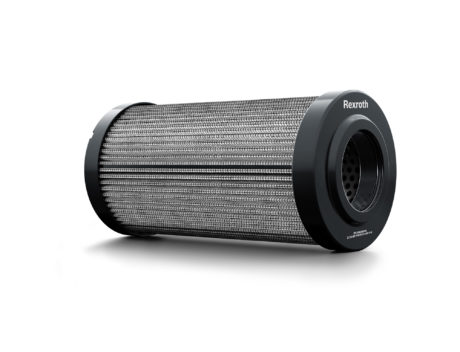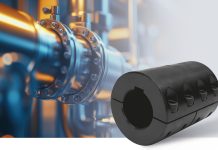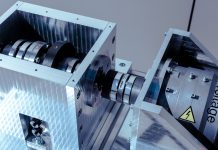Longer service life and reduced operating costs
Bosch Rexroth is introducing a new generation of filter media, using state-of-the-art materials and advanced designs to protect hydraulic systems, reduce overall costs and improve hydraulic total cost of ownership (TCO).
Similar to pathogens in humans, particles in the hydraulic fl uid, invisible to the naked eye, can lead to malfunctions and permanent damage even in large systems – and as hydraulic technologies are engineered to tighter tolerances and utilize higher pressures, sensitivity to particle contamination has increased. It is useful to take into consideration several key aspects of filtration, in order for hydraulic systems users to make intelligent and effective use of this newest generation of filter media. These considerations include:
- Cleanliness requirements of hydraulic systems
- Technical criteria for fi lter selection:
– Filter rating
– Retention rate
– Dirt holding capacity
– Pressure diff erential
- Controlling/reducing life cycle costs.
Requirements for hydraulic systems cleanliness
For centuries, people attributed contagious diseases to a wide variety of causes because they were not able to detect pathogens such as viruses or bacteria without microscopes and scientific
insights. In hydraulic systems, many malfunctions are caused by very small particles in the hydraulic oil as well. According to research, contamination is the number one cause for failures of hydraulic systems accounting for 80 percent of these failures. Solid particles are primarily responsible for abrasion in components. Their eff ect depends on the particle’s shape, hardness and material composition. Rigid and sharp-edged parts are the most common cause of damage. Furthermore, the level of damage and abrasion depends on factors including working fluid pressure, size and geometry of the particle, and particle velocity, among others.
Generally speaking, the higher the system’s working pressure, the more forcefully particles will be pressed into component gaps, thus increasing the risk and potential severity of the system damage. One source of contamination is the production and assembly of new hydraulic systems. Even with extremely thorough cleaning prior to system commissioning, contamination cannot be completely removed and then gets into the hydraulic fluid during operation over time. During operation, dirt may enter into the system from the plant air or via the piston rods. Internally,
particles are mainly produced by the abrasion and erosion of metal components and seals. Chemically generated substances, such as oil aging products, oxidation residues and substances insoluble in oil due to the mixing of oils, are additional contamination sources.
Not visible to the naked eye
Contamination particles in hydraulic fluids are classified based on their size in thousandth of a millimeter (μm). With optimum lighting conditions, the human eye can see objects only down to a size of 40 μm. The particles which are particularly dangerous for hydraulic systems are 15 μm and smaller and can therefore not be detected in a visual inspection. Users can only determine the actual contamination level using particle counters. There are two possibilities. Users take an oil sample either regularly or after special occurrences and analyze it for contamination. The second option is the integration of a particle counter in the hydraulic circuit. In this way, users can continuously monitor the contamination with particles.
Contamination risks with new fluids
New hydraulic fluids can have a high level of contamination, which is why users should not assume that new operating liquids are particularly clean and therefore safe. Particularly after filling systems with new hydraulic fluids, filtration is extremely important. Best practices can include performing professional fl uid analysis to gain information on the actual contamination of the hydraulic fluid; if possible, new fluid should be filtered once before being added to hydraulic systems.

Technical criteria for fillter selection
Filters clean operating liquids by retaining particles of a defined size in the filter material. They thus guarantee proper function and a long life cycle of the hydraulic system. There are four important criteria that industrial operators should consider when selecting the right filter for their equipment:
- Filter rating
- Retention rate
- Dirt holding capacity
- Pressure diff erential
Only the overall consideration of all properties leads to the optimum technical and economical solution. Recently developed filter materials have set new standards regarding economic efficiency.
Filter rating:The tolerated particle size in a hydraulic fluid results from the fitting tolerance or as well from the lowest gap of the component applied in the system. In combination with the system pressure as well as the general sensitivity of a component, the so called fl uid cleanlineness is derived and stated in the data sheet of the respective component. Particles, which often show a laminar type due to the chipping type of their appearance can move without in general causing damage even through the smaller tolerances of e.g. a gear pump (<0,5 μm). High-class filter elements are as well able to segregate even smaller particles than indicated on the grade of filtration. The indicated grades of filtration are therefore to be understood as recommendation which are collected due to a long-time experience of different systems. Besides the pollution with particles the users have to take into consideration also more influences by environmental conditions and production processes. To this are counted among e.g. the infl uence on the filtration bearing by water or air in the oil.
Retention rate: The retention rate indicates how many particles of a certain size are retained in the filter mesh and how many reach the clean side. This ratio is measured in ßx according to ISO 16889. The number of particles in the specified filter rating is measured upstream and downstream of the filter. If one of 100 retained particles reaches the clean side, then the ß-value is 100 for the specified filter rating x. If the considered size “x”, e.g. 10 μm has reached a ß-value of minimum 200, then the fi lter is by definition according to the DIN24550 a filter with the fineness 10 μm. Depending on the filter rating, new fllter materials have ß-values between 200 and 1,000.
As a result, users achieve excellent filtration performance and increase their system availability thanks to optimally cleaned hydraulic fluids.
Dirt holding capacity: The dirt holding capacity is also measured according to ISO16889 and indicates the capacity of a fi lter and is the decisive factor for the duration of the replacement intervals. The more dirt is absorbed by a filter, the longer the replacement interval and the lower the filtration costs. Compared to the previous generation, newly developed filter elements absorb up to 50 percent more particles thanks to ideally engineered multi-layer filter materials made of glass fi bers. They therefore have a longer service life and reduce the life cycle costs of the hydraulic system.
Pressure differential: Every filter element causes a differential presssure between the clean side and the dirt side. This differential pressure is rated for the filter element itself and for the filter by the test method ISO 3968. While the filter is working the quantity of contamination and the filter efficiency have influence on the level of the differential pressure.
The higher the flow resistance the liquid has to overcome the more pressure gets lost and has to be re-created with a lot of energy. In spite of a higher retention rate and dirt hold capacity the new filter materials have still a very low starting differential pressure.
Reducing life cycle costs
Effective filtration increases the availability and life cycle of hydraulic systems. However, there are operational costs associated with the proper use of fluid filtration: labor and downtime costs required for exchanging fi lter elements on a regular basis. In this regard, newly developed fi lter elements can reduce the life cycle costs in several ways:
- The dirt holding capacity which is increased up to 50 percent prolongs the replacement intervals. This means a reduction in labor, material and disposal
costs.
- The optimum retention rate of the new filter elements and their electrical conductive properties reliably protect hydraulic systems and prevent damage or system downtime due to contamination -which is the cause of 80 percent of hydraulic system failures.
Conclusion
Hydraulic fluid is often referred to as the “life-blood” of hydraulic systems – and with good reason: keeping this fluid clean and contaminant-free is essential to preventing damage and increasing the life cycle of these systems. Newly developed fi lter materials for more powerful filter elements reduce the operating costs by ensuring a longer service life.
For future filter exchanges, users should therefore first compare the technical specifications of filter elements by different suppliers. Independent of the manufacturer of the filter housing, the operating costs can be significantly reduced by using the new generation of filter media.



